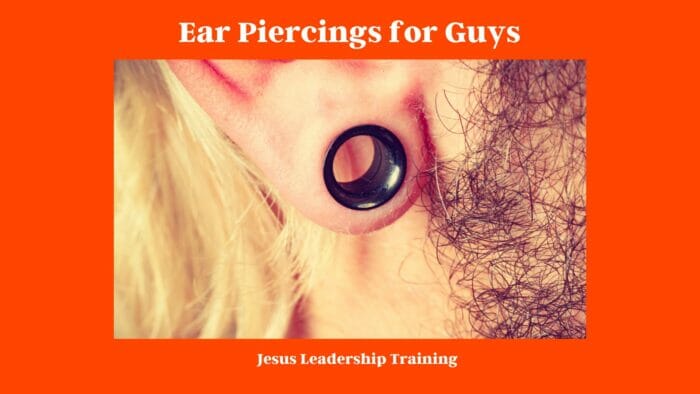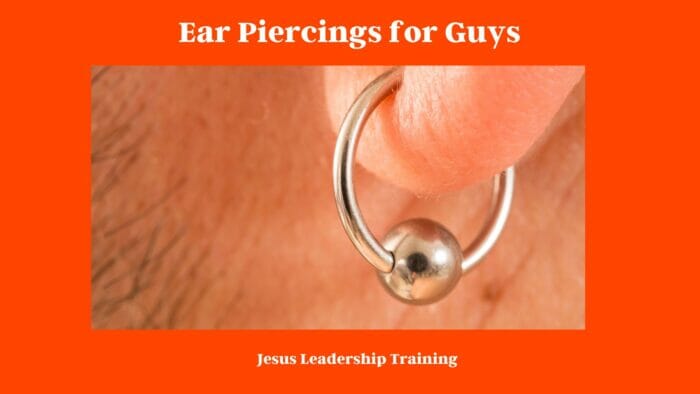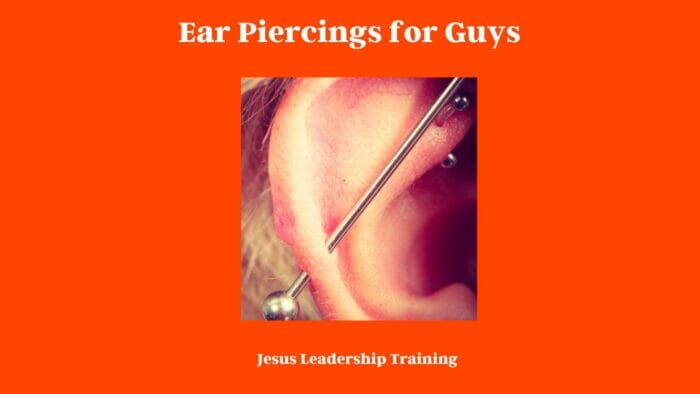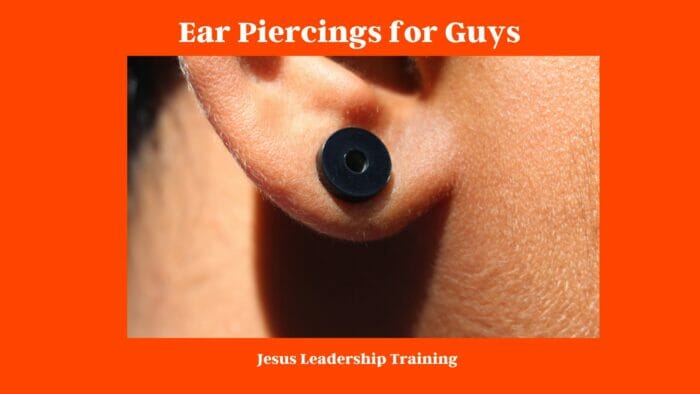Ear Piercings for Men – When it comes to defining individual style and making a personal statement, men’s fashion has ventured beyond typical domains and embraced more diverse trends – ear piercings being a prominent example. Originating in ancient cultures and fuelled by a shifting societal acceptance, ear piercings have evolved far beyond being mere fashion accessories for men.
Table of Contents
Ear Piercings for Men
As we journey through the historical significance and cultural dynamics that have shaped this trend’s evolution, it’s important to understand the different types and styles of ear piercings found among men today.
Certainly! The Bible makes a few mentions of earrings and other forms of jewelry in both the Old and New Testaments. Here’s a table showcasing those references:
Biblical References to Earrings
| Biblical Location | Description |
|---|---|
| Genesis 24:22, 30, 47 | In the story of Abraham’s servant finding a wife (Rebekah) for Isaac, the servant gifts Rebekah a gold nose ring and two gold bracelets. These served as tokens of his master’s wealth and intent. |
| Genesis 35:4 | Following God’s command, Jacob instructs his household to rid themselves of foreign gods. As a sign of purification and dedication to God, the people give Jacob their foreign gods and their earrings, and he buries them under an oak near Shechem. |
| Exodus 32:2-3 | Aaron asked the Israelites to give him their gold earrings to craft the golden calf. The people willingly complied, taking off their earrings and bringing them to Aaron, who then fashioned it into an idol. This event was a significant act of disobedience against God’s commandment not to create or worship any graven image. |
| Exodus 35:22 | When Moses asked the Israelites for offerings to construct the Tabernacle, both men and women willingly brought their gold earrings and other jewelry as contributions. |
| Judges 8:24-26 | Gideon requested gold earrings from the plunder the Israelites took from their defeated Midianite enemies. The gold earrings of the Midianites became a significant portion of the loot, and Gideon used them to make a golden ephod, which the Israelites later idolized, leading them astray. |
| Job 42:11 | After Job’s trials and God’s restoration, all of Job’s brothers, sisters, and friends visited him, bringing him a piece of silver and a gold ring (or earring) as gifts. |
| Proverbs 25:12 | Earrings (or rings) of gold and an ornament of fine gold is likened to a wise reprover to a listening ear, indicating the value of heeding wise reproof. |
| Ezekiel 16:11-12 | God, describing Jerusalem’s former glory and beauty, mentions adorning her with earrings, among other jewelry, symbolizing His blessings and favor. However, this passage also highlights how Jerusalem subsequently used these adornments in idol worship and spiritual unfaithfulness. |
| Hosea 2:13 | God, speaking through the prophet Hosea, condemns Israel for forgetting Him and attributes their adornment with jewelry, including earrings, to their pursuit of other lovers (idols). This passage symbolically communicates Israel’s unfaithfulness to God. |
These passages provide a glimpse into the cultural and religious significance of earrings and other jewelry within the context of ancient Israelite society and their relationship with God. In most contexts, jewelry, including earrings, is neutral or positive, representing wealth, status, or beauty. However, they become problematic when associated with idolatry or forgetting one’s covenant with God.
Historical Significance and Evolution
Historical Significance of Ear Piercings for Guys
Ear piercings in men have held various significances across different cultures and periods in human history. For instance, ancient Egyptian pharaohs and nobles often had their ears pierced, which was a symbol of their higher status. In addition, ear piercings held spiritual importance in some tribes and echoed the courage of warriors in certain societies

. As another example, in many cultures like the Maasai in Africa, ear piercing and stretching were symbols of wisdom, age, and responsibility in the community. Interestingly, seafarers adorned an ear piercing, particularly in the left ear, in the belief that it improved their long-distance sight, a superstition prominent during the Golden Age of Piracy.
Let’s delve into history and explore notable examples of men donning earrings across various epochs and cultures:
Men Wearing Earrings Through History
| Historical Period / Culture | Notable Examples | Description |
|---|---|---|
| Ancient Civilizations | Pharaohs and Noblemen of Ancient Egypt | Earrings symbolized status and wealth in Ancient Egypt. Pharaoh Tutankhamun, for instance, was found with ear piercings. |
| Ancient Persia | Persian Soldiers | Depictions on ancient Persian reliefs, such as those at Persepolis, show soldiers adorned with an array of jewelry, including earrings. |
| Ancient Rome | Roman Slaves | While earrings were popular among women of status, male slaves were sometimes given a gold earring after earning their freedom. |
| Medieval Europe | European Nobility | In the Middle Ages, it was common for European royalty and noblemen to wear elaborate jewelry, including earrings, as a symbol of their stature. |
| 16th Century | Sir Francis Drake | The famed English sea captain and pirate is believed to have sported an earring, possibly believing in the superstition that pierced ears improved eyesight. |
| Pirates of the High Seas | Various Pirates | Legends have it that pirates wore earrings to fund a proper burial or due to superstitions, like warding off seasickness or drowning. |
| 18th Century India | Mughal Emperors | Mughal portraits depict emperors like Akbar and Jahangir wearing earrings, symbolizing both luxury and their unique style. |
| Native American Tribes | Various Tribal Chiefs and Warriors | Many Native American tribes viewed earrings as symbols of tribal identity, spiritual protection, and milestones in one’s life. |
| 20th Century Western Pop Culture | Harrison Ford, Michael Jordan, David Beckham | During the late 20th century, many celebrities and sports figures popularized earrings, challenging traditional gender norms and influencing global trends. |
This table encapsulates a broad spectrum of history, showing that the practice of men wearing earrings isn’t a recent phenomenon. Instead, it’s deeply rooted in diverse traditions, aesthetics, and sociocultural contexts.
Emerging Trends in Men’s Ear Piercings
Ear piercing among men has taken on a more fashion-forward approach in modern society, pushing past its traditional boundaries. A pivotal change happened in the 1970s when renowned male figures in the Western world began sporting pierced ears, sparking a newfound interest among males across the globe

. From there, the trend steadily gained traction, fueled by evolving gender norms and growing acceptance for self-expression. The 1990s saw the rise of dual-ear piercings among men, effectively shattering the stereotype that earrings were exclusive to women.
Presently, both single and double ear piercings, along with multiple piercings and earlobe stretching or “gauging”, are widely seen in men. This signals the continued evolution of this trend that spans both culture and fashion.
Which Ear to get Pierced for Men
Piercing the Left Ear
Pros:
- Traditional Masculinity: Historically in Western culture, the left ear has been associated with heterosexual masculinity. In the 1980s and ’90s, there was an unspoken rule known as the “gay ear” myth, suggesting that a piercing in the right ear indicated homosexual orientation, while the left indicated heterosexuality. Although this notion is outdated and no longer widely held, some may still perceive the left ear as a safer choice.
- Fashion Statement: Many male celebrities have popularized left ear piercings, making it a trendy option.
- Cultural Acceptance: In various cultures, the left ear is traditionally the preferred choice for the first piercing for men.
Cons:
- Stereotyping: Choosing to pierce the left ear based on outdated beliefs or societal pressures can perpetuate stereotypes.
- Lack of Individuality: Given its popularity, piercing the left ear might not stand out as unique.

Piercing the Right Ear
Pros:
- Challenging Norms: Piercing the right ear can be seen as an act of challenging outdated societal norms and stereotypes.
- Symbol of Openness: For some, it’s a symbol of being open-minded and not adhering strictly to traditional gender norms.
- Unique Style: Given the historical context, some might view the right ear piercing as more unique.
Cons:
- Possible Stereotyping: Even though it’s an outdated and fading belief, some might still associate the right ear piercing with the “gay ear” myth.
- Cultural Variances: In certain cultures, the right ear might not be the traditional choice for men, potentially leading to misunderstandings.
It’s essential to underscore that in today’s progressive and open society, such delineations and myths about ear piercings are becoming obsolete. The choice of which ear to pierce should primarily be based on personal preference and individual style, rather than societal beliefs or outdated stereotypes. Everyone should feel empowered to make choices that reflect their identity, aesthetics, and comfort.
Types and Styles of Ear Piercings for Men

19 Men’s Piercings and Their Descriptions
| Piercing Type | Description |
|---|---|
| Lobe Piercing | The traditional and most common piercing, placed through the fleshy bottom part of the earlobe. |
| Upper Lobe Piercing | Situated above the standard lobe piercing, closer to the cartilage region of the earlobe. |
| Helix Piercing | Located on the upper outer rim of the ear. Can have single or multiple piercings in this area. |
| Forward Helix | Positioned on the front side of the upper ear, right above the tragus. |
| Tragus Piercing | Placed in the small pointed eminence of the outer ear, directly in front of the ear canal. |
| Anti-Tragus | Situated opposite the tragus, on the outer ear, just above the earlobe. |
| Daith Piercing | Located in the innermost fold of the ear, where the ear connects to the head. |
| Conch Piercing | Can be either inner or outer conch. The inner conch is in the center cartilage adjacent to the ear canal, while the outer is on the outer ear’s flat part. |
| Rook Piercing | Positioned on the anti-helix region, above the tragus. |
| Snug Piercing | Located on the inner cartilage of the ear, it’s a bit above the anti-tragus piercing. |
| Industrial Piercing | A barbell connecting two pierced holes, often the helix and forward helix. |
| Nostril Piercing | Positioned on either side of the nostril. It’s a common facial piercing for men. |
| Septum Piercing | Goes through the nasal septum, with the jewelry usually sitting in the middle of the nostrils. It’s often called a “bull-ring piercing.” |
| Eyebrow Piercing | Typically placed vertically on the outer third of the eyebrow, though placement can vary. |
| Lip Piercing | Can be placed in various positions around the mouth – such as labret (below bottom lip), Monroe (above top lip), or snake bites (two on either side of lips). |
| Tongue Piercing | Positioned typically in the middle of the tongue, but can also be placed on the sides as ‘venom’ piercings. |
| Nipple Piercing | Can be done horizontally or vertically through the base of the nipple. |
| Navel Piercing | While more common among women, some men also opt for this piercing in the top rim of the navel. |
| Dermal Piercing | Single-point surface piercings, where jewelry sits on the surface of the skin and is anchored underneath. Can be placed almost anywhere on the body. |
This table provides an overview of the diverse range of piercings available to men today. Each type offers a unique aesthetic and allows for individual expression, underlining the versatility and expansive nature of body art in contemporary times.
Men’s Lobe Piercing
The most prevalent form of ear piercings among men is lobe piercing. This procedure involves creating a puncture in the soft lower part of the ear, more commonly referred to as the earlobe. Generally viewed as less painful than other forms of ear piercings, lobe piercings also tend to heal relatively quickly.
Most men choose to have a single lobe piercing in either one or both ears, although there are those who prefer multiple piercings. Jewelry options run the gamut from understated studs to more pronounced hoops, allowing for both traditional and trendy aesthetical expressions based on individual tastes.
Helix and Industrial Piercings for Men
Helix piercings are another popular style of ear piercing among men. This type of piercing involves the upper cartilage area of the ear. Traditional helix piercings are usually located on the outer rim of the ear, while forward helix piercings sit closer to the head.
Helix piercings, inclusive of the trendy double or triple helix set, offer a unique aesthetic and attract attention to the contour of the ear. Industrial piercings, a variant of the helix, involve two holes in the upper ear cartilage connected by a single straight piece of jewelry, usually a barbell, giving an undeniably bold statement.
Exploring Diverse Ear Piercing Options for Men
It’s noteworthy to mention a few types of distinctive ear piercings for men, often considered less conventional yet highly stylish. The tragus piercing, for instance, targets the small piece of cartilage situated directly in front of the ear canal.
Attractive Male Piercings
Health Considerations and Care
Here’s a table detailing the steps involved in various types of men’s ear piercings:
Steps for Various Types of Men’s Ear Piercings
| Type of Piercing | Steps for Piercing |
|---|---|
| Lobe Piercing | 1. Clean the earlobe thoroughly with an antiseptic solution. 2. Mark the desired location for precision. 3. Use a sterilized needle or piercing gun to make the piercing. 4. Insert the chosen earring. 5. Clean and apply an antibiotic ointment. |
| Upper Lobe Piercing | 1. Sterilize the upper lobe area. 2. Carefully mark the spot. 3. Pierce using a sterilized needle. 4. Place the jewelry. 5. Cleanse the area and provide aftercare instructions. |
| Helix Piercing | 1. Thoroughly disinfect the upper outer rim of the ear. 2. Mark the exact piercing spot. 3. Use a sterilized hollow needle to pierce. 4. Insert the jewelry. 5. Offer aftercare advice. |
| Forward Helix | 1. Clean the front upper section of the ear. 2. Mark the location. 3. Utilize a sterilized hollow needle for piercing. 4. Insert the selected earring. 5. Apply antiseptic solution and guide on aftercare. |
| Tragus Piercing | 1. Disinfect the small protruding part of the outer ear. 2. Accurately mark the piercing point. 3. Use a sterilized hollow needle to pierce. 4. Secure the jewelry. 5. Clean the area and provide aftercare directions. |
| Daith Piercing | 1. Clean the innermost cartilage fold thoroughly. 2. Mark the exact spot for piercing. 3. Pierce with a sterilized curved needle. 4. Insert the chosen jewelry piece. 5. Guide on cleaning and aftercare. |
| Conch Piercing | 1. Sterilize the central cartilage or outer flat part of the ear. 2. Mark the desired location. 3. Employ a sterilized hollow needle for piercing. 4. Place the jewelry. 5. Offer cleaning and aftercare guidelines. |
| Industrial Piercing | 1. Clean both the intended entry and exit points on the ear. 2. Mark both spots for precise alignment. 3. Pierce the first point and then the second one. 4. Insert a barbell through both piercings. 5. Detail aftercare instructions. |
It’s crucial to remember that all piercings should be executed by a professional piercer in a sterile environment. Proper aftercare is imperative to prevent infections and ensure smooth healing. Each person’s healing time can vary, and following the provided aftercare regimen is essential to the process. Always consult with a professional before making decisions regarding piercings.
Understanding the Health Implications of Ear Piercings in Men
While personal style is important, it is essential to prioritize one’s health when considering ear piercings. The primary health concern in this context is the potential threat of infection.
If piercing tools aren’t sterilized sufficiently or the aftercare regimen isn’t followed correctly, a bacterial infection could ensue, characterized by symptoms such as painful, swollen earlobes and discharge. Certain individuals may also exhibit allergic reactions to some earring materials, especially those that contain nickel. Additionally, although rare, there is a risk of contracting a serious blood-borne disease such as hepatitis if the piercing is done under unsanitary conditions.
Therefore, these concerns highlight the critical need for making a well-informed decision and choosing a skilled, reputable professional piercer adhering to stringent hygiene guidelines.
Aftercare and Maintenance
After getting an ear piercing, it’s essential to take steps to prevent infection and ensure a smooth healing process. For the healing period, which usually ranges from six weeks to few months, avoid touching the area unnecessarily and always wash your hands before handling the piercing.
Saline solution is often recommended for cleaning the pierced area twice daily. It’s important not to remove or change the earring during the initial healing stages, as this can interrupt the healing process and potentially introduce bacteria.
After the piercing has fully healed, earrings should ideally be worn continuously for the first year to prevent the hole from closing. Remember to still periodically clean both the earrings and your ears to keep infection risks at bay. Different styles of earrings, like hoops or plugs, may require additional maintenance and cleaning precautions to stay sanitary and safe.
Health considerations and proper aftercare are critical aspects that cannot be underestimated while deciding to get an ear piercing. It’s not just about embracing a trend, but also about being responsible for your own wellbeing. Proper knowledge about potential health risks, precautions, healing processes and steps needed to prevent infections is a must.
Final Thoughts – Ear Piercings for Men
The journey of getting an ear piercing might be infused with style ascendancy and perhaps, a walk down the cultural lane, but it’s the conscious responsibility towards care that truly encapsulates the experience. So, before you step into the world of ear-piercing, gear up with the right knowledge and attitude in order to truly enjoy this personal expression of style.
Best Bible Encyclopedias and Dictionaries
Below is a table featuring some highly regarded Bible Encyclopedias and Dictionaries along with their publishers and websites where they can be found or purchased.
| Title | Publisher | Website |
|---|---|---|
| The International Standard Bible Encyclopedia | Eerdmans | Eerdmans |
| Zondervan’s Pictorial Bible Dictionary | Zondervan | Zondervan |
| Easton’s Bible Dictionary | Thomas Nelson | Thomas Nelson |
| Holman Illustrated Bible Dictionary | B&H Publishing Group | B&H Publishing Group |
| The New Unger’s Bible Dictionary | Moody Publishers | Moody Publishers |
| HarperCollins Bible Dictionary | HarperOne | HarperOne |
| Vine’s Complete Expository Dictionary of Old and New Testament Words | Thomas Nelson | Thomas Nelson |
You can generally find these resources on the publishers’ websites, as well as other online book retailers such as Amazon or Christianbook. It’s always good practice to confirm availability and review additional details on the specific websites or other reliable online bookstores.





